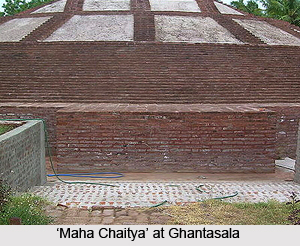 Ghantasala town and Mandal headquarters are existent in Krishna District in the southern Indian state of Andhra Pradesh. It is based at a distance of nearly 21 km from the western portion of Machilipatnam and about 11 km from the eastern side of Krishna River. Located about 60 km away from Ghantasala is Vijayawada, which is the largest city of Krishna District. This region is historically significant since it possesses some famous Buddhist sculptures, and it was proclaimed as a historical site during the period 1870 to 1871, by the British East India Company. A stupa in Ghantasala measuring about 23 feet in height and 112 feet in circumference was unearthed by Alexander Rea. Ancient Buddhist slabs and relics have been found in 1919 to 1920.
Ghantasala town and Mandal headquarters are existent in Krishna District in the southern Indian state of Andhra Pradesh. It is based at a distance of nearly 21 km from the western portion of Machilipatnam and about 11 km from the eastern side of Krishna River. Located about 60 km away from Ghantasala is Vijayawada, which is the largest city of Krishna District. This region is historically significant since it possesses some famous Buddhist sculptures, and it was proclaimed as a historical site during the period 1870 to 1871, by the British East India Company. A stupa in Ghantasala measuring about 23 feet in height and 112 feet in circumference was unearthed by Alexander Rea. Ancient Buddhist slabs and relics have been found in 1919 to 1920.
Once a prosperous town of Indo-Roman commerce, Ghantasala was also known to be a well-known religious spot. There have been instances of carved limestone columns which are associated with Buddhist monastic settlements belonging to 2nd and 3rd centuries BC at Ghantasala. Besides, a stupa or `Maha Chaitya` displaying a unique pattern, composed of bricks at the centre is another structure which is praiseworthy. The cube of solid bricks situated at the central part of the Chaitya is embedded with 12 constellations inspired by the zodiac. These Chaityas served as residences of the Buddhist monks and were popular during the era of the Satavahana Dynasty. Lime mortars and marvellous plasters made up the walls of the stupa. Yet another interesting structure is a beautifully carved structure adorned with the figurines of two garland bearers on the dome, a miniature stupa based on a throne at the centre and a `Dhamma Chakra`. A `purna kalasa` carved with lotus flowers, suggesting the birth of Lord Buddha, which measured four-by-three-feet. Concentric inner wheels are also a part of the stupa.
The carved slabs belonging to the stupas are today exhibited in various museums scattered across London and Paris. Presently, there exists a museum at Ghantasala which consists of some Buddhist slabs and relics which have been discovered recently. The town of Ghantasala has been declared as one of the tourist locales of the state by the Government of Andhra Pradesh. A Shiva temple known as Jaladheeswara Swamy Temple, constructed by `devathas` is present here, which is referred to as `chinna kasi`. The idols of Goddess Parvathi and Lord Shiva have been placed on the same `peetham` in this particular temple. It is believed that the very first rite was performed here by Adi Shankaracharya. `Sasti` is celebrated with great pomp and glory in the temple premises during November, every year. Numerous Pujas are offered at this temple during `Kartika` month.
Visiting Information
The airport of Vijayawada is present at a distance of nearly 20 km away, at a region called Gannavaram. Vijayawada is connected to Hyderabad and Vishakhapatnam by airway and the airport which is closest to Vijayawada is based in Hyderabad. Roadways are also utilized to approach Vijayawada from Machilipatnam. From Machilipatnam, buses are readily available which will help travellers to commute to Ghantasala. Private transport and private buses can also be availed from Challapalle in Krishna District.



















